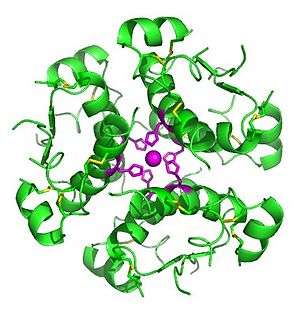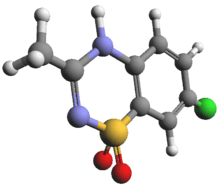Congenital hyperinsulinism
| Congenital hyperinsulinism | |
|---|---|
 | |
| Insulin (which this condition creates in excess) | |
| Classification and external resources | |
| ICD-9-CM | 251.1 |
| eMedicine | article/923538 |
Congenital hyperinsulinism is a medical term referring to a variety of congenital disorders in which hypoglycemia is caused by excessive insulin secretion.[1][2] Congenital forms of hyperinsulinemic hypoglycemia can be transient or persistent, mild or severe. These conditions are present at birth and most become apparent in early infancy.Mild cases can be treated by frequent feedings, more severe cases can be controlled by medications that reduce insulin secretion or effects[1][3]
Types
There are differenct types of congenital hyperinsulinism as indicated below:
- Diffuse hyperinsulinism
- Autosomal recessive forms
- SUR1 mutations
- Kir6.2 mutations
- Congenital disorders of glycosylation
- Short chain acyl coenzyme A dehydrogenase deficiency
- Autosomal dominant forms
- Glucokinase gain-of-function mutations
- Hyperammonemic hyperinsulinism (glutamate dehydrogenase gain-of-function mutations)
- Autosomal recessive forms
- Transient neonatal hyperinsulinism
- Beckwith-Wiedemann syndrome (thought to be due to hyperinsulinism but pathophysiology still uncertain: 11p15 mutation or IGF2 excess)
- Focal hyperinsulinism
Signs/symptoms
Hypoglycemia in early infancy can cause jitteriness, lethargy, unresponsiveness, or seizures.[4] The most severe forms may cause macrosomia in utero, producing a large birth weight, often accompanied by enlargement of the heart (cardiomegaly) and liver. Milder hypoglycemia in infancy causes hunger every few hours, with increasing irritability or lethargy if feeding is delayed.Congenital hyperinsulinism often becomes apparent later via an inability to sleep through the night. Sometimes an unusual stress like an illness precipitates a severe hypoglycemic episode.Milder forms have occasionally been detected by investigation of family members of infants with severe forms. Adults with the mildest degrees of congenital hyperinsulinism may simply have a decreased tolerance for prolonged fasting.
The variable ages of presentations and courses suggest that some forms of congenital hyperinsulinism, especially those involving abnormalities of KATP channel function, can worsen or improve with time the potential harm from hyperinsulinemic hypoglycemia appears to depend on the severity, frequency, and duration. Children who have recurrent hyperinsulinemic hypoglycemia in infancy can suffer harm to their brains and may have developmentally delay.
Cause
The cause of congenital hyperinsulinism has been linked to anomalies in nine different genes.[5] The diffuse form of this condition is inherited via the autosomal recessive manner.[4]
Diagnostic

In terms of the investigation of congenital hyperinsulinism, valuable diagnostic information is obtained from a blood sample drawn during hypoglycemia, detectable amounts of insulin during hypoglycemia are abnormal and indicate that hyperinsulinism is likely to be the cause.[6] Inappropriately low levels of free fatty acids, beta-hydroxybutyrate and ketones provide additional evidence of insulin excess. If this critical cannot be obtained during an early episode of spontaneous hypoglycemia, a diagnostic fast may be required.An additional piece of evidence indicating hyperinsulinism is a usually high requirement for intravenous glucose to maintain adequate glucose levels. The minimum glucose required to maintain a plasma glucose above 70 mg/dl is referred to as the glucose infusion rate. A GIR above 8 mg/kg/minute in infancy suggests hyperinsulinism. A third form of evidence suggesting hyperinsulinism is a rise of the glucose level after injection of glucagon at the time of the low glucose.
Once the evidence indicates hyperinsulinism, the diagnostic efforts shift to determining the type- elevated ammonia levels or abnormal organic acids can indicate specific, rare types. Intrauterine growth retardation and other perinatal problems raise the possibility of transience, while large birthweight suggests one of the more persistent conditions. Evidence for specific type can include responsiveness to some of the therapeutic measures. Genetic screening is now available within a useful time frame for some of the specific conditions.It is usually worthwhile to identify the minority of severe cases with focal forms of hyperinsulinism because these can be completely cured by partial pancreatectomy. A variety of pre-operative diagnostic procedures have been investigated but none has been established as infallibly reliable. Positron emission tomography (PET scanning) is becoming the most useful imaging technique and usually indicates whether the entire pancreas is producing too much insulin or whether a focal area is to blame.
Treatment

In terms of treatment, acute hypoglycemia is immediately reversed by raising the blood glucose, but in most forms of congenital hyperinsulinism hypoglycemia recurs and the therapeutic effort is directed toward preventing falls and maintaining a glucose above 70 mg/dl (3.9 mM). Some of the following measures are often tried:
- Chlorothiazide[2]
- Recombinant IGF-I [1]
- Continuous feeding with formula through a nasogastric tube or gastrostomy[1]
- Dextrose[2]
- Glucocorticoid[1]
- Diazoxide [7]
- Octreotide [7]
- Glucagon [7]
- Nifedipine or other calcium channel blocker[2]
- Pancreatectomy[7]
_CRUK_287.svg.png)
Each treatment has its limitations and disadvantages or hazards. Many of the treatments do not effectively maintain a satisfactory blood glucose in the more severe cases. Many of the treatments aggravate the poor feeding behavior that often accompanies severe congenital hyperinsulinism. It is hard for parents to continue frequent feedings for many months. Increased calories and corn starch may produce excessive weight gain. Unexpected interruptions of continuous feeding regimens can result in sudden, severe hypoglycemia. Insertion and maintenance of nasogastric tubes is distasteful to parents. Gastrostomy tube insertion requires a minor surgical procedure. Prolonged glucocorticoid use incurs the many unpleasant side effects of Cushing's syndrome. Diazoxide can cause fluid retention requiring concomitant use of a diuretic, and prolonged use causes hypertrichosis. Diazoxide works by opening the KATP channels of the beta cells, and many of the Kir and SUR mutations are unresponsive. Octreotide must be given by injection several times a day or a subcutaneous pump must be inserted every few days. Octreotide can cause abdominal discomfort and responsiveness to octreotide often wanes over time. Glucagon requires continuous intravenous infusion, incurring the infection and blood clot hazards of prolonged central venous lines.

Nifedipine is effective only in a minority, and dose is often limited by hypotension. Pancreatectomy (removal of a portion or nearly all of the pancreas) is usually a treatment of last resort when the simpler medical measures fail to provide prolonged normal blood sugar levels. For many decades, the most common surgical procedure was removal of about 95% of the pancreas. This cured some infants but not all, and some needed second procedures to remove even the last remnants. Insulin-dependent diabetes mellitus commonly develops, though in many cases it occurs many years after the pancreatectomy.In the early 1990s it was discovered that a sizeable minority of cases of Kir and SUR mutations were focal, involving overproduction of insulin by only a portion of the pancreas. These cases can be cured by removing much less of the pancreas, resulting in excellent outcomes with no long-term problems.
History
This condition has been referred to by a variety of names in the past 50 years, nesidioblastosis and islet cell adenomatosis were favored in the 1970s, beta cell dysregulation syndrome or dysmaturation syndrome in the 1980s, and persistent hyperinsulinemic hypoglycemia of infancy (PHHI) in the 1990s.
See also
References
- 1 2 3 4 5 Glaser, Benjamin (1 January 1993). "Familial Hyperinsulinism". GeneReviews(®). University of Washington, Seattle. Retrieved 9 October 2016.update 2013
- 1 2 3 4 "Congenital Hyperinsulinism: Background, Pathophysiology, Etiology". 2016-07-01.
- ↑ "Familial hyperinsulinism | Genetic and Rare Diseases Information Center(GARD) – an NCATS Program". rarediseases.info.nih.gov. Retrieved 28 November 2016.
- 1 2 Reference, Genetics Home. "congenital hyperinsulinism". Genetics Home Reference. Retrieved 2016-10-07.
- ↑ Rahman, Sofia A.; Nessa, Azizun; Hussain, Khalid (1 April 2015). "Molecular mechanisms of congenital hyperinsulinism". Journal of Molecular Endocrinology. 54 (2): R119–R129. doi:10.1530/JME-15-0016. ISSN 0952-5041. Retrieved 28 November 2016.
- ↑ Hussain, K. (August 2005). "Congenital hyperinsulinism". Seminars in Fetal and Neonatal Medicine. 10 (4): 369–376. doi:10.1016/j.siny.2005.03.001. Retrieved 28 November 2016. – via ScienceDirect (Subscription may be required or content may be available in libraries.)
- 1 2 3 4 Yorifuji, Tohru (28 November 2016). "Congenital hyperinsulinism: current status and future perspectives". Annals of Pediatric Endocrinology & Metabolism. 19 (2): 57–68. doi:10.6065/apem.2014.19.2.57. ISSN 2287-1012. Retrieved 28 November 2016.
Further reading
- Pinney, Sara E.; MacMullen, Courtney; Becker, Susan; Lin, Yu-Wen; Hanna, Cheryl; Thornton, Paul; Ganguly, Arupa; Shyng, Show-Ling; Stanley, Charles A. (1 August 2008). "Clinical characteristics and biochemical mechanisms of congenital hyperinsulinism associated with dominant KATP channel mutations". The Journal of Clinical Investigation. 118 (8). doi:10.1172/JCI35414. ISSN 0021-9738. Retrieved 12 October 2016.
- Hoyme, edited by Louanne Hudgins, Helga V. Toriello, Gregory M. Enns, H. Eugene; Toriello, Helga V.; Enns, Gregory M.; Hoyme, H. Eugene (2014). Signs and symptoms of genetic disease : a handbook. Oxford: Oxford University Press. ISBN 9780199930975.
- Hertz, edited by David E. (2005). Care of the newborn a handbook for primary care. Philadelphia: Lippincott Williams & Wilkins. ISBN 9780781755856.